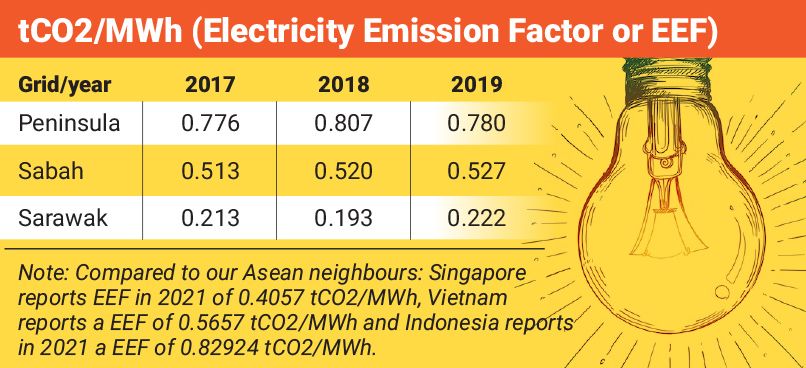I AM highly elated by the joint announcement of the Ministry of Natural Resources, Environment and Climate Change (NRECC) and the Ministry of Economy in addressing the Renewable Energy (RE) challenges plaguing Malaysia with the uplifting of the RE target and RE export ban.
Indeed, I shared some of these challenges in my previous column in The Star of April 25, 2023 and the need of the hour for Malaysia to bite the bullet.
Kudos to the NRECC and the Ministry of Economy for their political will, foresight and commitment in ensuring a sustainable future for our next generation with this strategic development and cross border trade policy for RE.
Sharing some facts on why such a policy is necessary and pertinent.
Malaysia’s Fourth Biennial Update Report submitted to the United Nations Framework Convention on Climate Change (UNFCC) in December 2022 by NRECC shows the following electricity emission factor (see chart): Thus, this marks a turning point in Malaysia’s transformative climate change transition towards sustainable development and leap-frogging the promotion of green energy in Asean.
This will also help create thousands of new job opportunities, attract foreign investment, and reduce Malaysia’s reliance on fossil fuels.
The NRECC must be highly commended in recommending some key initiatives:
Self-Contained Systems (SCS): I was asked after I responded to to the NRECC’s media statement on May 9 on my Linkedin, “What is meant by Self Contained Systems ?” My first response was to simply, “to put the grid on standby”.
This should also put an end to the proliferation of the Large-Scale Solar (LSS) or more than 30-megawtt plants. The LSS can at many a times be detrimental to the environment in terms of land use and its degradation including habitat loss and this could be replaced with the development of localised RE MW’s from roof tops and floating type solar solutions at disused mines, water harvesting bodies, water balancing dams, hydro dams and our indigenous biomass/ biogas plants plus our own waste to energy RE generation.
Rules on the present Corporate Green Power Plant could be further modified to include terms like the contracting of a solar plant should be limited to within 50km (crows flight) of the corporate buyer thus localising the solar generation, giving more local job opportunities and creating an embedded economy locally.In an effort to further decarbonise the grid locally and make it self-contained, stakeholders especially regulators could also look at:
> Waste heat recovery systems for small and medium enterprises and view it as an energy efficiency initiative to reduce energy intensity and introduce support policies to make it commercially viable.
> Support distributed co-generation (identified as a game changer), using our indigenous gas supply, would be a golden opportunity not to be missed as the gas industry already has a third party access policy since 2017 while electricity regulators are still mulling over MESI 2.0.
The benefits of an SCS include the following:
> Increased energy security: Self-contained systems ensure a reliable and secure energy supply, as they are not reliant on a centralised energy generation and are less vulnerable to disruptions in the grid system.
Here utility planners would need to equip themselves with the knowledge to not only ensure reliability but also to address resilience.
While reliability is “the quality of being trustworthy of performing consistently well,” grid resilience describes it as the ability to bounce back after network disruption. > Cost savings: Self-contained systems can result in cost savings, as they eliminate the need for expensive grid infrastructure and transmission lines.
In utilities, the transmission dept has always been seen superior over distribution dept due to their far higher allocated budget yearly. The capital expenditure presently used to gold plate the Malaysian transmission grid can be better spent on addressing smarter self-contained grids.
This should include not only allowing consumers to self-generate thus reducing their reliance on energy from traditional brown sources and potentially lowering their energy bills but making some simple fundamental changes in policy like allowing customers to generate based on roof top size and capability against present regulation limiting them to 75% of their maximum demand.
This small change can bring about the required changes almost immediately as the rules on Net Energy Metering (NEM) and Self Consumption under the NOVA framework have already been long established and utility metering system is already robust enough to accommodate these changes.
Storage thus becomes an additional opportunity, once cross subsidies are carefully removed and tariffs reflect actual Cost of Supply, thus allowing prosumers to decide between exporting to grid or storing for later use.
> Environmental benefits: Self-contained systems promote the use of local renewable energy sources, like solar, hydro, waste to energy, biomass and biogas, thus reducing greenhouse gas emissions and promoting environmental sustainability. In the early 1980’s many rural electrification projects were done via run-of-the-river with minimum water storage, which were then eventually abandoned once these villages received grid connected supply.
This is an area that should be re-explored entrepreneurially.
> Direct allocation to government departments: The RM50mil allocation for governmentt buildings to acquire solar under the existing NEM GoMEn is another measure, besides being strategic also addresses the operational needs of ministries.
While the NEM GoMEn scheme is not new, where generation from roof tops to the grid is sold on a one-to-one basis (grid as battery concept), the take-up rate from NEM GoMEn scheme has been low not only due to budget constraints and red tape but there is also a dire need to address the lack of contractual obligation understanding by legal officers on distributed generation, as they are more proficient in contracting traditional supply source from the grid.
> Allowing cross border trading of Renewable Energy Certificates (RECs): This will have a positive impact on Nationally Determined Contributions (NDCs) targets against just trading on merely international or local carbon credits. NDCs are at the heart of the Paris Agreement and the achievement of its long-term goals. NDCs embody efforts by each country to reduce national emission and adapt to the impacts of climate change.
Malaysia should see the uplifting of RE intercountry trade as an opportunity to reduce its electricity emission factor from 0.78 tCO2/MWh as compared to its Asean neighbours with a higher generation mix from RE and supported by funds derived from sale of RECs in its bid to attract more foreign direct investment.
This emission factor reduction would itself be an attraction to industries seeking to reduce their carbon footprint through investment in a well decarbonised grid. It is probably worth noting that electricity emission factors refer to the amount of greenhouse gases (usually carbon dioxide) that are emitted per unit of electricity generated on the country’s power grid.
The emission factors depend on the type of fuel used for power generation (for example coal, natural gas, renewables) and the efficiency of the power plants. Countries declare on grid emission factors in UNFCC reports while commercial and industrial consumers declare on their carbon footprint reduction efforts under the three Green House Gas scopes to meet their environmental, social and governance obligations.
While the sale of RECs under the Green Energy Tariff scheme from LSS plants and large hydro plants goes into government coffers with little information on how these funds are used, regulators implementing these cross border REC mechanism should take cognisance from the present CGPP scheme, to ensure revenue from RECs is passed back to RE developers. This will allow the growth of a transparent, robust and a consumer centric REC market .
Among the main reasons multinational companies from compliance markets support the purchase of RECs is to allow the funds to be used by RE developers to further grow the RE generation market thus displacing fossil fuel in the longer run and not to meet any country’s NDC targets.Moving forward, Malaysia needs the undivided support and cooperation of all players from various ministries, regulators, industries and prosumers to work in tandem and to ensure that the direction taken is not disrupted by “Little Napoleons” seeking a hidden agenda that is different as set by the NRECC.
While it cannot be denied that all new paths come with risks, coupled with inter-country regulatory challenges, lack of utility infrastructure, inter-Asean market rules and market risks. This is the one task, Malaysia must take to put Asean onto the world map by becoming the third economy that can pride in its electricity connectivity apart from the United States, Canada and European nations.
The time is now for Malaysia to deliver and make its mark in climate change and sustainability globally.
Nirinder Singh Johl is the founder and CEO of Asia Carbon XChange PLT. He was formerly the managing director of TNBX, a subsidiary of Tenaga Nasional Bhd. The views expressed here are the writer’s own.



